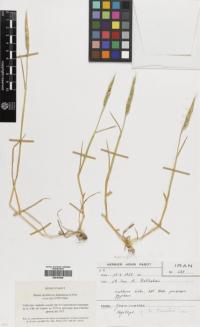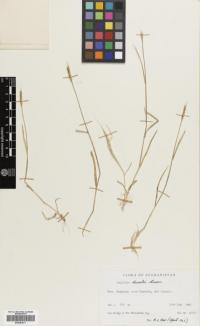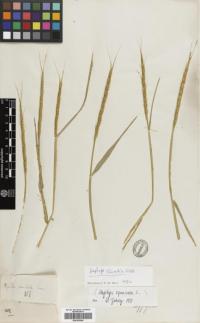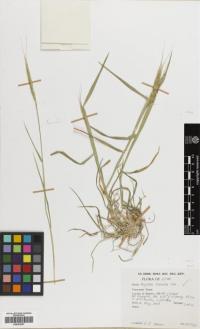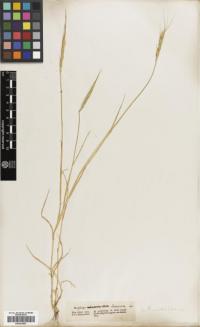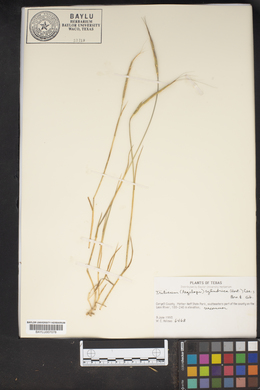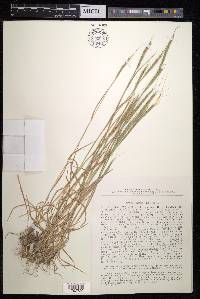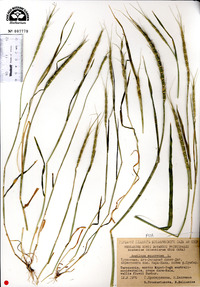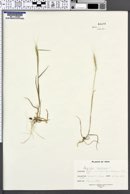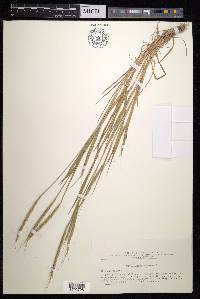
|
|
|
|
Family: Poaceae
Tausch's Goat Grass, more...Tausch's goatgrass, Rough-Spiked Hardgrass
[Aegilops squarrosa of authors, moreAegilops squarrosa subsp. eusquarrosa , Aegilops squarrosa var. anathera , Aegilops squarrosa var. meyeri , Aegilops squarrosa var. squarrosa , Aegilops strangulata (Eig) N. N. Tzvelev, Triticum aegilops P. Beauv. ex Roem. & Schult., Triticum tauschii (Coss.) Schmalh.] |
Culms 20-45 cm, geniculate at the base, usually forming many tillers. Sheaths with hyaline margins, lower cauline sheath margins usually ciliate; blades 6-20 cm long, 3-6 mm wide. Spikes 5.5-8.2 cm long, 0.3-0.6 cm wide, narrowly cylindrical to slightly moniliform, with 6-12 spikelets; rudimentary spikelets absent; disarticulation in the rachises, the spikelets falling attached to the internodes above. Spikelets 7-8 mm long, 3-4 mm wide, cylindrical, scabrous, with 2-5 florets, distal 2 florets sterile. Glumes 5-7 mm, coriaceous, scabrous, rims thickened, apices obtuse to truncate, minutely denticulate, unawned; lemmas 6-8 mm, toothed and usually awned, awns usually solitary, awns of the lower spikelets to 4 cm, awns of the apical spikelets to 5.5 cm. Caryopses 5-6 mm, adhering to the lemmas and paleas. Haplomes D. 2n = 14. Aegilops tauschii is a weed of disturbed areas. In the Flora region, it is known only from Riverside County, California, Cochise County, Arizona, and an old collection from Westchester County, New York. It is native from the Caucasus and southern shores of the Caspian Sea, eastward to Kazakhstan and western China, and southward to Iraq and northwestern India. Dr. David Bogler, USDA NRCS PLANTS Database Annuals, Terrestrial, not aquatic, Stems nodes swollen or brittle, Stems geniculate, decumbent, or lax, sometimes rooting at nodes, Stems caespitose, tufted, or clustered, Stems terete, round in cross section, or polygonal, Stem internodes hollow, Stems with inflorescence less than 1 m tall, Stems, culms, or scapes exceeding basal leaves, Leaves mostly basal, below middle of stem, Leaves mostly cauline, Leaves conspicuously 2-ranked, distichous, Leaves sheathing at base, Leaf sheath mostly open, or loose, Leaf sheath smooth, glabrous, Leaf sheath and blade differentiated, Leaf blades linear, Leaf blade auriculate, Leaf blades 2-10 mm wide, Leaf blades mostly flat, Leaf blades mostly glabrous, Leaf blades more or less hairy, Leaf blades scabrous, roughened, or wrinkled, Ligule present, Ligule an unfringed eciliate membrane, Inflorescence terminal, Inflorescence simple spikes, Inflorescence spike linear or cylindric, several times longer than wide, Inflorescence single raceme, fascicle or spike, Inflorescence spikelets arranged in a terminal bilateral spike, Flowers bisexual, Spikelets sessile or subsessile, Spikelets laterally compressed, Spikelet less than 3 mm wide, Spikelets with 3-7 florets, Spikelets solitary at rachis nodes, Spikelets distichously arranged, Spikelets all alike and fertille, Spikelets bisexual, Inflorescence disarticulating between nodes or joints of rachis, rachis fragmenting, Spikelets disarticulating below the glumes, Spikelets falling with parts of disa rticulating rachis or pedicel, Spikelets closely appressed or embedded in concave portions of axis, Rachilla or pedicel glabrous, Glumes present, empty bracts, Glumes 2 clearly present, Glumes equal or subequal, Glumes equal to or longer than adjacent lemma, Glumes 4-7 nerved, Glumes 8-15 nerved, Lemma similar in texture to glumes, Lemma coriaceous, firmer or thicker in texture than the glumes, Lemma 5-7 nerved, Lemma glabrous, Lemma apex truncate, rounded, or obtuse, Lemma distinctly awned, more than 2-3 mm, Lemma with 1 awn, Lemma awn 2-4 cm long or longer, Lemma awned from tip, Lemma awns straight or curved to base, Lemma margins thin, lying flat, Lemma straight, Palea present, well developed, Palea membranous, hyaline, Palea shorter than lemma, Palea 2 nerved or 2 keeled, Palea keels winged, scabrous, or ciliate, Stamens 3, Styles 2-fid, deeply 2-branched, Stigmas 2, Fruit - caryopsis, Caryopsis ellipsoid, longitudinally grooved, hilum long-linear, Caryopsis hairy at ape x.
|
|
|
|


